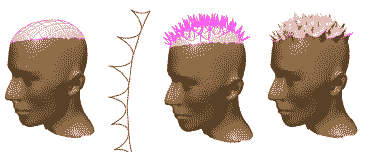
Source:http://graphics.cs.uiuc.edu/~zelinka/mmca/mmca_sig2003sk.pdf
Steve Zelinka Michael Garland
University of Illinois at Urbana–Champaign

Figure 1: Left to right: original mesh, with un ltered target curves; sample curves: un ltered green, ltered blue; ltered target curves; transformed mesh.
1 Introduction
True Mesh Analogies, in which a mesh is transformed by producing an example of the desired transformation, would be a useful mod-elling tool. Analogies support a very wide range of transformations without having to write speci c code for each, as well as allowing unskilled users to make relatively complex transformations so long as they can nd or create an example of the transformation. However, generalizing analogies from images [Hertzmann et al. 2001] or curves [Hertzmann et al. 2002] to meshes, beyond the technical challenges, puts an increasing burden on the user in creating or nding the example transformation; while even novices may be comfortable editing images or curves, few methods allow novice users to easily edit a mesh. We therefore develop an alternate, less powerful approach using Curve Analogies directly.
First, the user selects a set of target curves embedded in the surface. The user then speci es a transformation to be applied to the curves by sketching a pair of sample curves. Using Curve Analogies, we reproduce the transformation between the two sample curves on all of the surface curves. Finally, these transformed curves are used to drive a transformation of the surface.
2 Curve Selection
The space of lters which may be applied to a mesh using our approach is contingent on the set of curves selected to be transformed. Typically, we simply slice the surface by sets of parallel or rotating planes, and use the resulting intersection curves. Note that one set of parallel planes would preclude control over features emergent over the direction of the plane normal, so we typically use two or more (usually orthogonal) sets of parallel planes. Rotating planes can be useful for objects which are (or nearly are) rotationally symmetric. Other useful sets of target curves include iso-parameter lines, for parameterized surfaces, and silhouette curves.
3 Surface Transformation
Our surface transformation procedure is inspired by the Wires system [Singh and Fiume 1998]. Each curve in uences all mesh vertices within a user-speci ed distance. Each in uenced vertex is

moved in the direction its closest point on the untransformed curve is moved, with the magnitude of the change a function of the approximate geodesic distance of the vertex to the curve. When multiple curves in uence a vertex, its nal position is a weighted average of the positions suggested by each curve, using the same distance-based weighting. Note that we assume the sample density of the original mesh is high enough to support the transformation, and we may produce some smoothing at vertices with multiple in uences.
4 Discussion
We have used our approach to apply a number of different lters to meshes, including local feature additions, smoothing, and low frequency enhancements. Results typically take a few minutes, depending on the number of curves and the required sample densities.
Rotationally invariant Curve Analogies can be dif cult to control, as the orientation of a lter can change (e.g., from adding bumps to creating indentations). We are addressing this by incorporating the orientation of the surface into the Curve Analogy generation. Also, we may create self-intersections in the surface, though this should be relatively easy to avoid.
References
HERTZMANN, A., JACOBS, C. E., OLIVER, N., CURLESS, B., AND SALESIN, D. H.
2001. Image analogies. In Proceedings of ACM SIGGRAPH 2001, ACM Press / ACM SIGGRAPH, New York. E. Fiume, Ed., Computer Graphics Proceedings, Annual Conference Series, ACM, 327–340.
HERTZMANN, A., OLIVER, N., CURLESS, B., AND SEITZ, S. M. 2002. Curve analogies. In Proceedings of the Thirteenth Eurographics Workshop on Rendering, 233–245.
SINGH, K., AND FIUME, E. 1998. Wires: A geometric deformation technique. In Proceedings of ACM SIGGRAPH 98, ACM Press / ACM SIGGRAPH, New York.
M. Cohen, Ed., Computer Graphics Proceedings, Annual Conference Series, ACM, 405–414.